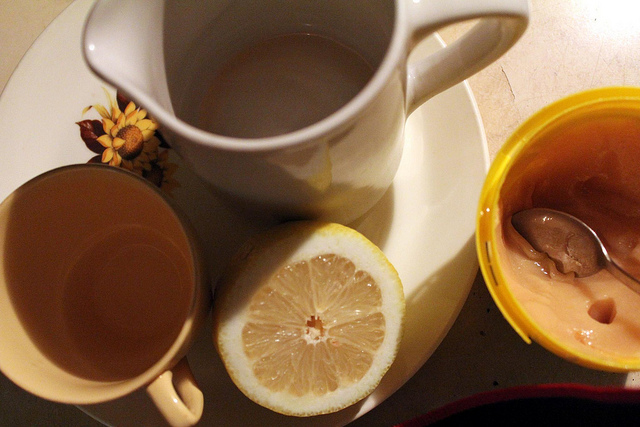~
I’ve spent all too many years battling with an upset tummy.
I’m talking about extreme bloating after eating a single almond, going for days without an appetite and experiencing embarrassing gurgling sounds after every meal—as well as consistently inconsistent poo (pardon my frankness).
But these symptoms weren’t enough to grab the attention of allopathic doctors. They checked me for parasites and called it quits—apparently I was healthy. But I knew that something was very wrong, even if no modern medical test could prove it.
It wasn’t until I came across ayurveda and was introduced to the concept of agni–the digestive fire–that my symptoms were finally validated. My agni was totally out of whack, and I had only been contributing to its demise with food and a lifestyle that were incompatible with my inherent nature. Realizing where I’d gone wrong and how to restore my digestive fire metamorphosed my health.
Rectifying the agni is the answer for anyone who suffers from digestive issues—which happens to be about 74% of us Americans. In fact it’s one of the most important things we can do for our health in general.
Ayurveda teaches that health begins in the gut. Both good health and disease boil down to the state of the digestive fire, as it’s responsible for transformation, assimilation and absorption of food.
The agni resembles a pot of food set over a small fire. If the fire burns brightly, the food will be cooked properly. But if the fire is too low, food won’t cook thoroughly and will eventually putrefy. If the fire is too strong, on the other hand, it will char food.
The same thing happens in the gut. When the agni is balanced, food is transformed into healthy body tissues. When it’s low, food spoils and turns into a putrid, sticky toxic buildup that ayurveda calls aama. (Aama is at the root of all disease). When the agni is too high, it digests not only food but the body tissues. And when its power is wavering, digestion teeters between all three states.
Impaired agni is primarily a result of improper diet and lifestyle. Common habits like stuffing oneself, eating before the previous meal is digested, eating whatever whenever and mental unrest—like stress, anxiety and anger—can also vitiate the agni. Even staying up too late at night, exercising in the middle of the day and taking naps can disrupt agni.
So how do you know if your agni is vitiated? If you feel full after eating a normal amount of food, have smelly burps during or after eating, hear or feel the process of digestion, feel like your food sits in your belly too long, lack a proper appetite or if your bowel movements are irregular—or anything but formed and floating—then your agni is out of balance.
Even if your agni is balanced, it’s important to eat and live in a way that supports its continued equilibrium.
Ayurveda has granted us much wisdom on this topic, and many of its guidelines are easily put into place:
1. You may have already picked up on the recent yogi obsession with hot water and lemon first thing in the morning. Ayurveda’s actually been recommending this practice for thousands of years, so it’s about time that we Western yogis caught on!
Early morning hot water can greatly improve the agni. The digestive fire is naturally low in the morning (which explains why we’re less hungry than at other times of day). Hot water adds fuel to the (digestive) fire—preparing the belly for the food that lies ahead. It also helps to flush out accumulated waste. Lemon increases water’s detoxification action, but it should be avoided by those with excess heat or acidity.
2. Because ginger naturally stimulates the appetite, a little ginger appetizer can greatly improve the agni. And having an appetite is a very good thing. Hunger signifies that the stomach has secreted digestive juices and is ready for food.
To make an agni-boosting ginger appetizer, peel and slice a 3” piece of ginger. Add a few squeezes of lime juice and a pinch of Himalayan salt. Let it marinate for a few hours. Eat a few slices before lunch and dinner, storing the remainder in the fridge.
3. Eating in a quiet and settled atmosphere can truly improve digestion. We often ignore this seemingly obvious principle, because our lives are busy, and the sacred ritual of eating takes second place to nearly everything else.
But holding space for relaxed mealtimes can really make all the difference in digestion. So put your work aside, turn off the television, sit down, say a little prayer and eat with your mind in a peaceful and undistracted state.
4. Ayurveda teaches that overloading the system too soon after a meal is a major cause of disease. It both weakens the agni and causes toxic buildup–aama. Give at least a few hours break between meals or snacks, waiting for the signs of proper digestion before eating again—hunger, thirst, lightness and enthusiasm.
5. We need to strike a balance between over-eating and under-eating to maintain a health agni. Over-eating not only leads to weight gain, but it impairs the digestive process by overloading the stomach. Under-eating—including excessive fasting, frequent cleanses and generally skipping meals—leads to the depletion of body tissues and overall body weakness.
To understand how much food is right for you, ayurveda recommends filling your belly 50% with food, 25% with liquids and leaving 25% empty for digestive juices and digestive action.
Ayurveda has so much more to say on digestion than these five principles alone, but they’re a perfect starting place to both nurture and re-balance the agni. I’ve personally experienced drastic improvements in my own digestion since implementing these concepts. Just a little bit of ancient, time-tested and completely logical wisdom goes a long way.
**Reference: Muniyal Ayurveda. Sacitra Caraka Samhita, Volume 1. Manipal: Dr. U. Krishan Muniyal Memorial Trust.
.
Relephant Mindful, ethical, sustainable product:
Relephant:
Tummy Troubles? Ayurveda Says to Stop Mixing These Foods.
.
Author: Julie Bernier
Editor: Yoli Ramazzina
Photo: Flickr/Various Brennemans
~
Bonus:












Read 2 comments and reply